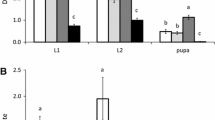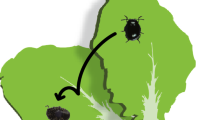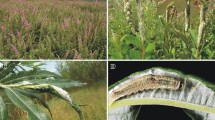Abstract
The eggs of the herbivorous false spider mite Brevipalpus obovatus Donnadieu have a longer incubation period than those of spider mites and are not protected by webs. Brevipalpus obovatus often lays its eggs in the gaps among the hairs on host leaves. We examined the effects of stellate hairs of Viburnum erosum var. punctatum (VEP) leaves on the survival of B. obovatus eggs. Adult B. obovatus and Phytoseius nipponicus Ehara, a generalist predator, were introduced to VEP leaf disks; each B. obovatus egg was inspected daily until hatching. More eggs (63 vs. 42 %) survived on the abaxial surfaces of VEP leaves, where the stellate hairs are more complicated, than on the adaxial surfaces. Predation hazard decreased rapidly with increasing egg age and a substantial portion of the eggs hatched. Phytoseius nipponicus preyed on eggs regardless of egg age when mixed-age eggs were provided. Manipulative experiments with bent stellate hairs showed that the normal hairs reduced the predation risk of B. obovatus eggs by P. nipponicus. Therefore, the predation hazard was considered to decrease since the stellate hairs hindered the search for B. obovatus eggs by the phytoseiid mite.





Similar content being viewed by others
References
Adobe Systems Incorporated (2002) Adobe Photoshop Elements. version 2.0. San Jose, California
Broström G, Holmberg H (2011) glmmML: Generalized linear models with clustering. version 0.81-8
Duso C, Vettorazzo E (1999) Mite population dynamics on different grape varieties with or without phytoseiids released (Acari: Phytoseiidae). Exp Appl Acarol 23:741–763
Duso C, Malagnini V, Paganelli A, Aldegheri L, Bottini M, Otto S (2004) Pollen availability and phytoseiid abundance (Acari: Phytoseiidae) on natural and secondary hedgerows. Biocontrol 49:397–415
Ehara S (1962) Notes on some predatory mites (Phytoseiidae and Stigmaeidae). Jpn J Appl Entomol Zool 6:53–60
Ehara S, Amano H (2009) Phytoseius (Dubininellus) nipponicus Ehara. In: Ehara S, Gotoh T (eds) Colored guide to the plant mites of Japan. Zenkoku Noson Kyoiku Kyokai, Tokyo (in Japanese), pp 96–97
Ehara S, Gotoh T (2009) Brevipalpus obovatus. In Ehara S, Gotoh T (eds.) Colored Guide to the Plant Mites of Japan, p. 152. Zenkoku Noson Kyoiku Kyokai, Tokyo (in Japanese)
Ferreira JAM, Pallini A, Oliveira CL, Sabelis MW, Janssen A (2010) Leaf domatia do not affect population dynamics of the predatory mite Iphiseiodes zuluagai. Basic Appl Ecol 11:144–152. doi:10.1016/j.baae.2009.10.008
Fukaya M, Uesugi R, Ohashi H, Sakai Y, Sudo M, Kasai A, Kishimoto H, Osakabe M (in press) Tolerance to solar ultraviolet-B radiation in the citrus red mite, an upper surface user of host plant leaves. Photochem Photobiol doi: 10.1111/php.12001
Goyal M, Sadana GL, Sharma NK (1985) Influence of temperature on the development of Brevipalpus obovatus (Acarina: Tenuipalpidae). Entomon 10:125–129
Gutschick VP (1999) Biotic and abiotic consequences of differences in leaf structure. New Phytol 143:3–18. doi:10.1046/j.1469-8137.1999.00423.x
Jeppson LR (1975) Chapter 2. Population ecology. In: Jeppson LR, Keifer HH, Baker EW (eds) Mites injurious to economic plants, pp. 17–46. University of California Press, Berkeley, California
Johnson HB (1975) Plant pubescence: an ecological perspective. Bot Rev 41:233–258. doi:10.1007/BF02860838
Karban R, English-Loeb G, Walker MA, Thaler J (1995) Abundance of phytoseiid mites on Vitis species: effects of leaf hairs, domatia, prey abundance and plant phylogeny. Exp Appl Acarol 19:189–197
Kreiter S, Tixier MS, Croft BA, Auger P, Barret D (2002) Plants and leaf characteristics influencing the predaceous mite Kampimodromus aberrans (Acari: Phytoseiidae) in habitats surrounding vineyards. Environ Entomol 31:648–660. doi:10.1603/0046-225X-31.4.648
Krips OE, Kleijn PW, Willems PEL, Gols GJZ, Dicke M (1999) Leaf hairs influence searching efficiency and predation rate of the predatory mite Phytoseiulus persimilis (Acari: Phytoseiidae). Exp Appl Acarol 23:119–131. doi:10.1023/A:1006098410165
Lill JT, Marquis RJ, Forkner RE, Le Corff J, Holmberg N, Barber NA (2006) Leaf pubescent affects distribution and abundance of generalist slug caterpillars (Lepidoptera: Limacodidae). Environ Entomol 35:797–806. doi:10.1603/0046-225X-35.3.797
Loughner R, Goldman K, Loeb G, Nyrop J (2008) Influence of leaf trichomes on predatory mite (Typhlodromus pyri) abundance in grape varieties. Exp Appl Acarol 45:111–122. doi:10.1007/s10493-008-9183-5
McMurtry JA, Croft BA (1997) Life styles of phytoseiid mites and their roles as biological control agents. Ann Rev Entomol 42:291–321. doi:10.1146/annurev.ento.42.1.291
O’Dowd DJ, Willson MF (1997) Leaf domatia and the distribution and abundance of foliar mites in broadleaf deciduous forest in Wisconsin. Am Midl Nat 137:337–348
Ohtsuka K, Osakabe Mh (2009) Deleterious effects of UV-B radiation on herbivorous spider mites: they can avoid it by remaining on lower leaf surfaces. Environ Entomol 38:920–929. doi:10.1603/022.038.0346
Onzo A, Sabelis MW, Hanna R (2010) Effects of ultraviolet radiation on predatory mites and the role of refuges in plant structures. Environ Entomol 39:695–701
Pina T, Argolo PS, Urbaneja A, Jacas JA (2012) Effect of pollen quality on the efficacy of two different life-style predatory mites against Tetranychus urticae in citrus. Biol Control 61:176–183. doi:10.1016/j.biocontrol.2012.02.003
R Development Core Team (2009) R: A language and environment for statistical computing, version 2.10.1. R Foundation for Statistical Computing, Vienna
Roda A, Nyrop J, Dicke M, English-Loeb G (2000) Trichomes and spider-mite webbing protect predatory mite eggs from intraguild predation. Oecologia 125:428–435. doi:10.1007/s004420000462
Roda A, Nyrop J, English-Loeb G, Dicke M (2001) Leaf pubescence and two-spotted spider mite webbing influence phytoseiid behavior and population density. Oecologia 129:551–560. doi:10.1007/s004420100762
Roda A, Nyrop J, English-loeb G (2003) Leaf pubescence mediates the abundance of non-prey food and the density of the predatory mite Typhlodromus pyri. Exp Appl Acarol 29:193–211
Saito Y (1985) Life types of spider mites. In: Helle W, Sabelis MW (eds.) Spider Mites. Their Biology, Natural Enemies and Control, Vol. 1A, pp. 253–264. Elsevier, Amsterdam
Saito Y (1986) Prey kills predator: counter-attack success of a spider mite against its specific phytoseiid predator. Exp Appl Acarol 2:47–62. doi:10.1007/BF01193354
Sakai Y, Sudo M, Osakabe M (2012) Seasonal changes in the deleterious effects of solar ultraviolet-B radiation on eggs of the twospotted spider mite, Tetranychus urticae (Acari: Tetranychidae). Appl Entomol Zool 47:67–73
Shah MA (1982) The influence of plant surfaces on the searching behavior of coccinellid larvae. Entomol Exp Appl 31:377–380. doi:10.1007/BF02996700
Sudo M, Osakabe M (2011) Do plant mites commonly prefer the underside of leaves? Exp Appl Acarol 55:25–38. doi:10.1007/s10493-011-9454-4
Sudo M, Osakabe M (in press) Geotaxis and leaf-surface preferences mitigate negative effects of a predatory mite on an herbivorous mite. Exp Appl Acarol doi: 10.1007/s10493-012-9622-1
Sudo M, Nishida S, Itioka T (2010) Seasonal fluctuations in foliar mite populations on Viburnum erosum Thunb. var. punctatum Franch. et Sav. (Adoxaceae) and sympatric shrubs in temperate secondary forests in western Japan. Appl Entomol Zool 45:405–415. doi:10.1303/aez.2010.405
Tachi F, Osakabe M (2012) Vulnerability and behavioral response to ultraviolet radiation in the components of a foliar mite prey-predator system. Naturwissenschaften 99:1031–1038. doi:10.1007/s00114-012-0984-3
Tian D, Tooker J, Peiffer M, Chung SH, Felton GW (2012) Role of trichomes in defense against herbivores: comparison of herbivore response to woolly and hairless trichome mutants in tomato (Solanum lycopersicum). Planta 236:1053–1066. doi:201210.1007/s00425-012-1651-9
van Haren RJF, Steenhuis MM, Sabelis MW, de Ponti OMB (1987) Tomato stem trichomes and dispersal success of Phytoseiulus persimilis relative to its prey Tetranychus urticae. Exp Appl Acarol 3:115–121. doi:10.1007/BF01270473
van Rijn PCJ, Tanigoshi LK (1999) Pollen as food for the predatory mites Iphiseius degenerans and Neoseiulus cucumeris (Acari: Phytoseiidae): dietary range and life history. Exp Appl Acarol 23:785–802
Walter DE (1996) Living on leaves: mites, tomenta, and leaf domatia. Ann Rev Entomol 41:101–114. doi:10.1146/annurev.en.41.010196.000533
Walter DE, Proctor HC (1999) Mites: ecology, evolution, and behaviour. CABI Publishing, Wallingford
Acknowledgments
We thank Prof. H. Amano and Dr. S. Yano of Kyoto University for valuable suggestions. This study was partially supported by Grants-in-Aid for Scientific Research (B) Nos. 22380036 to MO from the Ministry of Education, Culture, Sports, Science and Technology, Japan and Grant-in-Aid for JSPS Fellows Nos. 23.2696 to SM from Japan Society for the Promotion of Science (JSPS).
Author information
Authors and Affiliations
Corresponding author
Electronic supplementary material
Below is the link to the electronic supplementary material.
Rights and permissions
About this article
Cite this article
Sudo, M., Osakabe, M. Stellate hairs on leaves of a deciduous shrub Viburnum erosum var. punctatum (Adoxaceae) effectively protect Brevipalpus obovatus (Acari: Tenuipalpidae) eggs from the predator Phytoseius nipponicus (Acari: Phytoseiidae). Exp Appl Acarol 60, 299–311 (2013). https://doi.org/10.1007/s10493-012-9648-4
Received:
Accepted:
Published:
Issue Date:
DOI: https://doi.org/10.1007/s10493-012-9648-4




